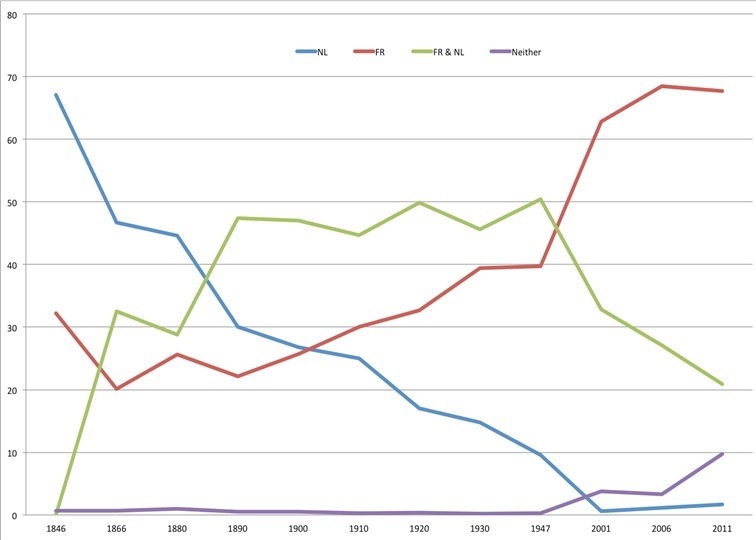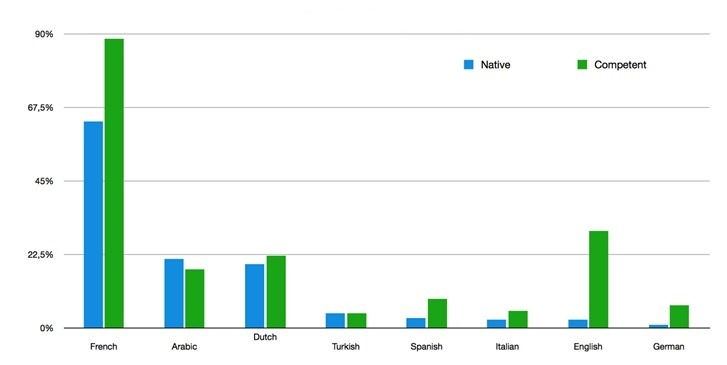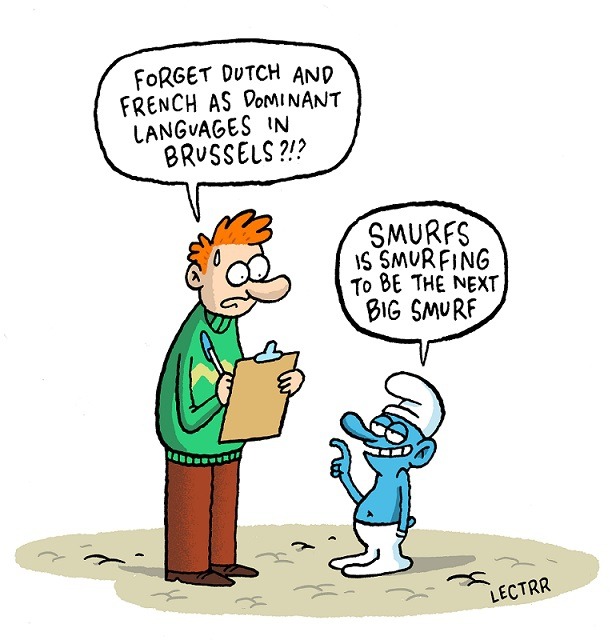The Kingdom of Belgium, you must have read somewhere, is a federal state that consist of two big monolingual regions and a tiny bilingual one. Is that so? Not quite. True, Dutch is the sole official language of Flanders, with the exception of “facilities” for French speakers in a handful of communes, mostly around Brussels. True too, French is the sole official language of Wallonia, with the exception of a handful of communes near the German border, where German is the official language.
What about the third region, small but densely populated — over 10% of Belgium’s population on 0.5% of its surface — the Region of Brussels-Capital? It has two official languages on an equal footing, Dutch and French. This means that all official documents must be published in both languages, that both languages can be spoken in the parliament of the Brussels Region and in the councils of its nineteen municipalities, and that all publicly funded schools must use either Dutch or French as the medium of instruction.
In this sense, Brussels is bilingual. Does this mean that its population is bilingual, or at least that all Brusselers can speak either French or Dutch or both? This used to be the case. But the linguistic situation of the Brussels region has changed dramatically over the last two hundred years. Moreover, the beginning of the present century has witnessed a sudden break with some long-term trends.
Ever since the language border settled in the early Middle Ages, the bulk of the population of Brussels and its surroundings spoke Brabants, a version of Dutch (or Flemish, which is a variety of Dutch in about the same linguistic sense as American is a variety of English). From the moment the Dukes of Burgundy made Brussels their capital in the 15th century, however, the dominant language in a slowly growing elite was French.
In 1830, the Kingdom of Belgium was founded, like the French Republic at the end of the previous century, as an officially monolingual French-speaking state. It is only in 1898 that Dutch, spoken in some version by the majority of the population, was recognized as co-official at the level of the country, without this challenging the position of French in the capital as the dominant language in politics, education and administration.
Data on the linguistic competence of Brussels residents are available since shortly after Belgium’s independence [see insert]. What they show, between then and now, is a dramatic fall — from nearly 50% to practically nothing — in the proportion of Brusselers who know Dutch and no French.
This is matched by a no less dramatic increase — from 20% to over two thirds — in the proportion of Brusselers who know French and no Dutch [see Figure 1]. What happened? Not an exodus of monolingual Flemings compensated by an invasion of monolingual Walloons. Rather, a gradual “Frenchification” of Dutch speakers, whether original residents of Brussels or immigrants from Flanders.
Figure 1: Brussels Region 1846-2011: Knowledge of Dutch and French
Blue: Dutch and no French
Red: French and no Dutch
Green: Both Dutch and French
Purple: Neither Dutch nor French
Source: National census 1846-1947; Taalbarometer VUB 2001-2011.
From generation to generation, especially after the introduction of compulsory schooling, native speakers of Dutch living in Brussels first acquired French as the language of social mobility, typically by attending a French-medium school, which made them bilingual. And it the next generation, Dutch got lost as a result of people educated in French deciding not to transmit their native Dutch to their children, since French was anyway sufficient to get along in a Brussels environment increasingly dominated by it.
This explains why Dutch-French bilinguals formed a strong relative majority at close to 50% for nearly three quarters of a century, from the end of the 19th century to after World War II. [see Figure 1]. This is the period in which Brussels could be called bilingual in the pretty strong sense that half its population could speak both Dutch and French, a proportion that is now down to about 20%.
In the last fifty years or so, the increase in the proportion of Brusselers speaking French and no Dutch was no longer only, nor even mainly caused by this slow process of “Frenchification”. It was further accelerated by two more factors: the arrival of a great many immigrants and expats who knew no Dutch and saw no point in learning it, and the emigration of many Dutch-speaking Brusselers to the Flemish periphery surrounding Brussels, where Dutch was henceforth entrenched owing to the definitive fixation of the language border in the 1960s.
One might have thought that these various trends would continue up to a point where practically the whole Brussels population would consist of people knowing French and no Dutch. But with the 21st century came a threefold surprise. There is evidence that three long-term trends suddenly find themselves in the process of being broken.
Firstly, for the first time in recorded history, the proportion of Brusselers who know Dutch and no French is slowly increasing. This may be due in part to the growing presence of citizens from the Netherlands, but also to the decline in the knowledge of French by young people arriving from Flanders.
Secondly, the proportion of people who know French and no Dutch has seen its century-long steady progress halted. This has not happened because of more Francophone Brusselers now learning Dutch (even though there is some indication that this is happening too): the proportion of bilinguals French-Dutch keeps falling, indeed more quickly in ten years than in the previous fifty.
The main cause is rather to be found in the third and most striking new development: the fast swelling of a category that was insignificant throughout most of Brussels’s recorded linguistic history and now corresponds to 10% of the total: those who know neither Dutch nor French (beyond a rudimentary level), most of whom (8%), it turns out, know no English either.
What does all this lead to today? Let us first look, for each of Brussels’ main languages, at the proportion of adults who have it as their native language or one of their native languages (i.e. spoken at home as a child) [in blue in Figure 2]. French is clearly the dominant language, with two thirds of the Brusselers mentioning it as a native language. This is far more than the 21% for Arabic, which has now overtaken Dutch (20%) as Brussels’ second native language.
Figure 2: Brussels Region 2011: languages spoken at home as a child (in blue) and languages spoken well or very well
Source: Taalbarometer VUB 2011.
None of the other languages reaches 5%. It is worth noting, however, that the respondents who report French as their sole native language form only one third of the sample, whereas they were still over 50% five years earlier. The other third consists of people who had French at home as children, but combined with another language, most often Arabic or Dutch.
As we turn from native language to linguistic competence [in green in Figure 2], French, as should be expected, becomes even more dominant, with 89% claiming to know French well or very well. Despite being less often mentioned as a native language than Arabic, Dutch (with 23%) leaps ahead of Arabic (18%) in terms of competence.
Contrary to all other languages, there are less adults claiming competence in Arabic than adults who spoke some Arabic at home when they were children. Arabic is not taught at school, and many families of Moroccan origin (close to 20% of the Brussels population) switch entirely to French.
Unsurprisingly, however, the most spectacular difference between native language and competence concerns English. With 30% of competent speakers, it has clearly become Brussels’ second language. It is, however, noteworthy, that the proportion of competent speakers in all three of Brussels’ top languages has gone down in 2011 relative to five years earlier: from 96 to 89% for French, from 35 to 30% for English and from 28 to 23% for Dutch. The proportion of people competent in none of these three languages, by contrast, rose over the same period from 2.5 to 8%.
To sum up. Brussels is officially bilingual French-Dutch, but the proportion of its population that claims to speak both languages is now down to 20% and still declining. Especially in the last half century, Brussels has become increasingly multilingual in terms of both native language and competence.
In the representative yet small sample of 2500 Brusselers that provides us with the most reliable data on Brussels’ current linguistic situation, 104 distinct native languages were detected. Among the 1.200.000 Brusselers, one can safely bet that literally hundreds of languages are being spoken, albeit sometimes just by a single household.
Further, Brussels is a “francophone” city in the sense that two thirds of its population grew up with French present in the home context, albeit in half the cases in combination with another language. But it is definitely no longer on a path that would take it from a situation in which the bulk of the population had Dutch only as its sole mother tongue to one in which it will have French as its sole mother tongue. Brussels can also be called a “francophone” city in the sense that close to 90% of its population can speak it well or very well. But this proportion has recently started to decline, and in some environments it now faces competition with English as Brussels’ lingua franca.
Both a Flemish Reconquista and a linguistic cleansing on behalf of French are now obsolete dreams to be shelved forever. Brussels has no choice but to embrace its multilingual future.
How do we know what languages Brusselers can speak?
In 1846, a language question was included in Belgium’s first census after independence. It asked all residents of the country which language they spoke. Starting with the following census (1866) and until the last census with a linguistic part (1947), residents were no longer asked which language (in the singular) they spoke, but which languages (in the plural) they knew. Figure 1 shows the aggregate census results for the 19 municipalities that now form the Brussels Region.
Because of opposition by hundreds of Flemish mayors to the inclusion of a linguistic question, the 1957 census was postponed. Why this opposition? By virtue of legislation passed in the 1930s, the answers to this question determined the official linguistic status of a municipality. If the proportion of residents that declared they knew French exceeded some threshold, the official status of a municipality would switch from monolingual Dutch to bilingual. (In principle, this could also happen in the other direction, but never did.) As a result of this opposition it was decided in 1961 that the linguistic part of the national census would be scrapped. This is why the most recent linguistic data Belgium possesses covering its whole territory dates back to 1947.
Starting in 2001, however, the Flemish governments funds every five years a comprehensive language survey for the Brussels region, using a fairly representative sample of all adult logal residents. This is the Taalbarometer of the Vrije Universiteit Brussel. A book based on the 2011 Taalbarometer and making comparisons with the two earlier ones was published in both Dutch and French (Rudi Janssens, Meertaligheid als cement van de stedelijke samenleving, VUB Press, 2012; Le multilinguisme urbain. Le cas de Bruxelles, VUB Press, 2013).
By Philippe Van Parijs


